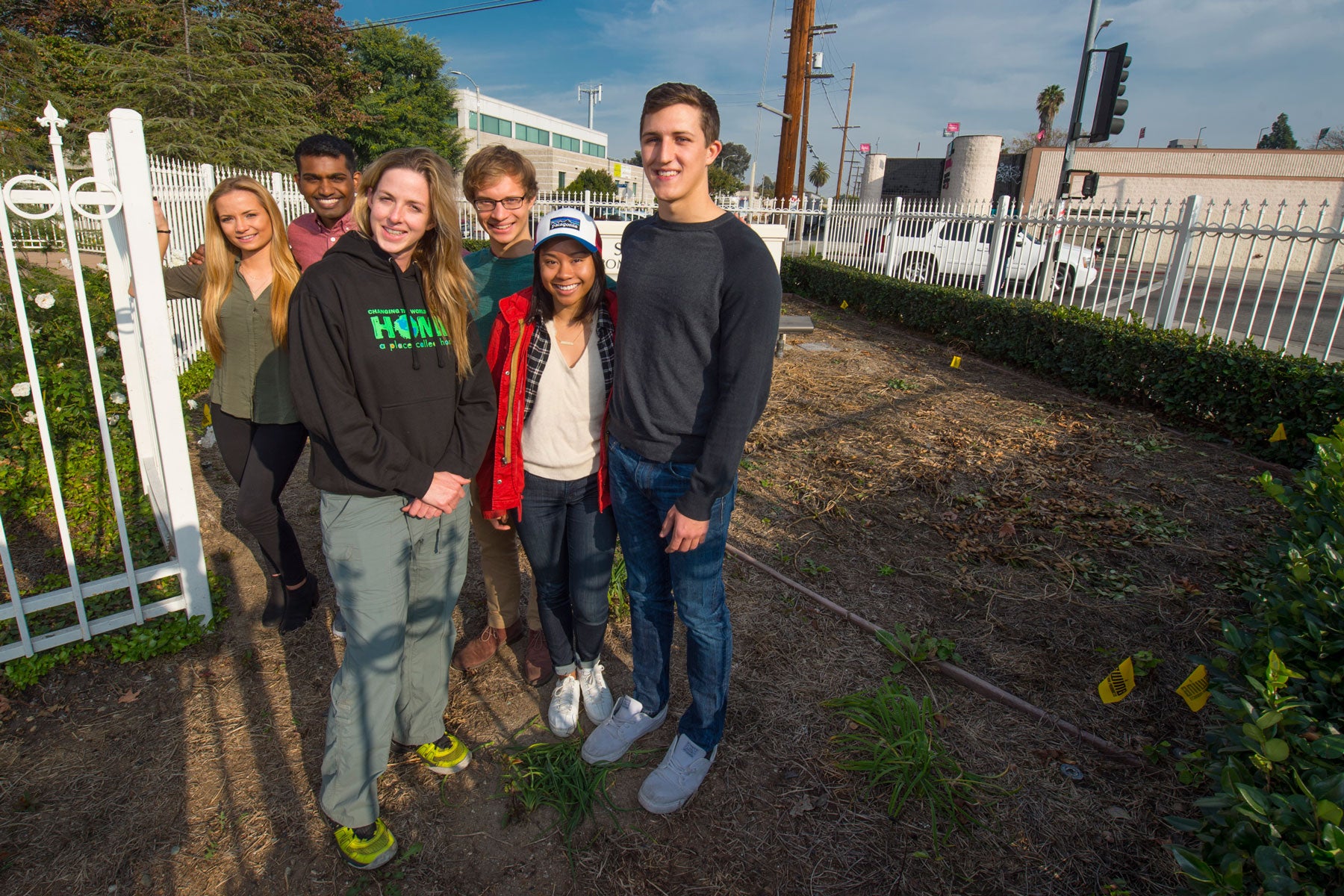Play all audios:
Neel Bhoopalam and four classmates step carefully around the small yellow flags dotting an L-shaped plot of dirt at Central Avenue and Jefferson Boulevard in South Los Angeles. The brightest
spots of color in the small lot, the flags mark the path of an underground sprinkler system for what will be an oasis of greenery and hope. The plot of land between St. Patricks Church
and the busy thoroughfare doesnt look like much yet. But before the spring semester is over, staff and volunteers at nearby nonprofit A Place Called Home will transform it into an urban
Garden of Eden featuring citrus, persimmon and pomegranate trees as well as greens, tomatoes and roses. When the plants mature, neighbors will take the bounty of organic flowers, fruit and
vegetables home. The transformation will take place thanks to a $10,000 grant that Bhoopalam and members of his class project team earned through a long-standing nonprofit management class
at the USC Price School of Public Policy. The class teaches students how to write and evaluate nonprofit grant applications, exposing them to real-world challenges while helping invest in
local solutions to wicked problems like homelessness and poverty. SURPRISING HOMEWORK Bhoopalam and most of his classmates learned on the first day of class that theyd be giving away real
dollars, which raised the stakes on their work beyond their final grades. > Id never heard of something like this being done in a class. > > Neel Bhoopalam Id never heard of
something like this being done in a class, said Bhoopalam, a senior majoring in computer science with an interest in social entrepreneurship. Cara Esposito MPA 09, DPPD 15, an adjunct
professor who teaches the unusual philanthropy course, explained to students that a donor who chose to remain anonymous had offered the money as a teaching tool, as well as an investment in
the community. Classwork that involves the reading of financial documents and budgets is more engaging when youre determining where to invest real grant money, she said. The funds also help
convey philanthropys most important lesson: There are many terrific nonprofits doing worthy projects and not enough money to fund them all. NARROWING A LONG LIST As the fall semester got
underway, the students researched Los Angeles nonprofits that sought funding. Using criteria such as organizational values and financial health, five teams of students each narrowed their
original list of nonprofits from as many as 21 organizations to one favorite. Deciding which nonprofit to back was the hardest part for his team of six, said student Calvin Legassick. Thirty
hours of research and discussion later, the students decided to pitch A Place Called Home to their classmates. So many organizations are doing heroic work, said Legassick, a senior
majoring in computer science. Then the students faced their next hurdle persuading classmates to back their choice of nonprofit. Along with the four other teams, Legassick and his mates
prepared and presented their best argument for why their favorite nonprofit should get the money. Students voted in two rounds, first selecting two finalists, then selecting one winner A
Place Called Home. THE NEIGHBORHOODS HAPPY PLACE Hannah Maluyao, a public relations major and senior, remembers her first time touring the after-school facility. On any given day, some 300
kids from ages 8 to 21 show up for educational, arts and athletic programs as well as counseling and mentoring services. Staff members also dish out more than 5,000 meals a month. There
were students dancing, making music and doing their homework, Maluyao said. They all seemed so happy to be there. Final funding for the urban garden had fallen through, staff told the
students. Without money, master gardener Maya Yaniv and her team would have to rely on volunteer labor for tasks like site preparation, irrigation system installation and planting, with
delays likely. The nonprofits gardens provide training in organic gardening as well as fresh food used in its nutrition program. These gardens not only improve access to fresh, locally
grown produce, but also create employment opportunities for youth, Yaniv said. At the garden site, Yaniv showed the students a few areas where planting had begun. We were thrilled to have
been selected, she said. The students grant will help complete planting for the gardens grand opening in April. The students looked around the dirt lot, where Yaniv said the future fruit
trees and vegetable plants would go. Their thrill at earning the grant funds for A Place Called Home is tinged with regret at not being able to give more to other organizations. The need,
theyve learned firsthand, is great. Philanthropy is challenging, Bhoopalam said. I knew it was difficult work going into the class, but after this semester I realized it was even harder
than I imagined.

